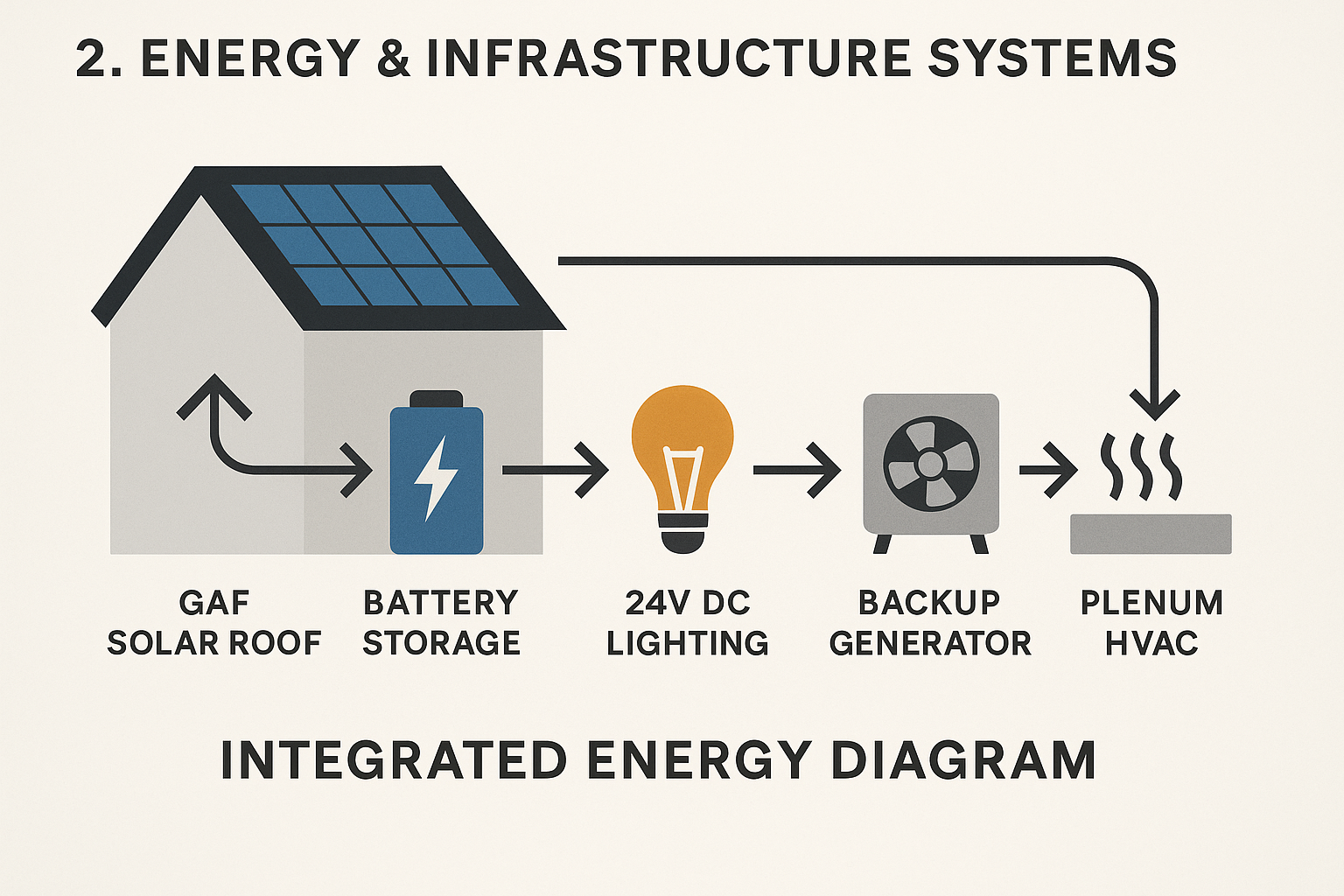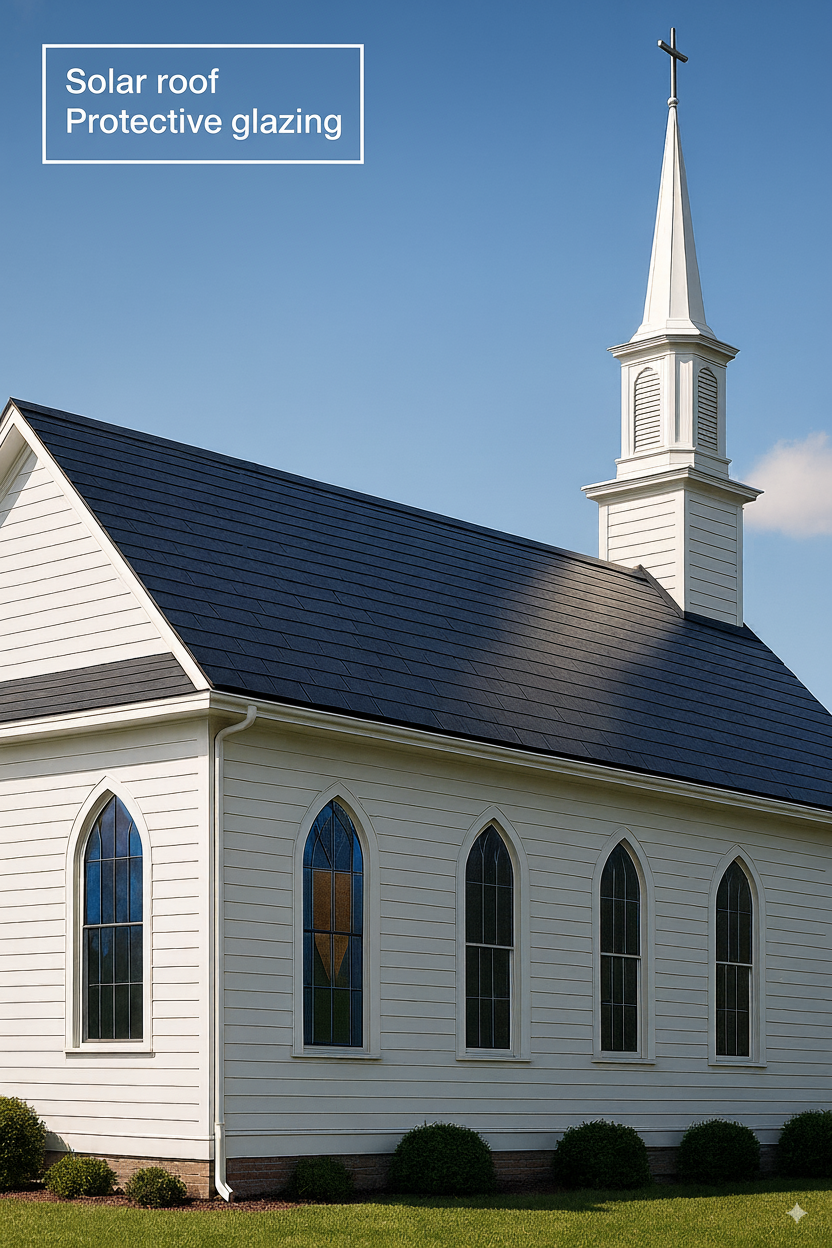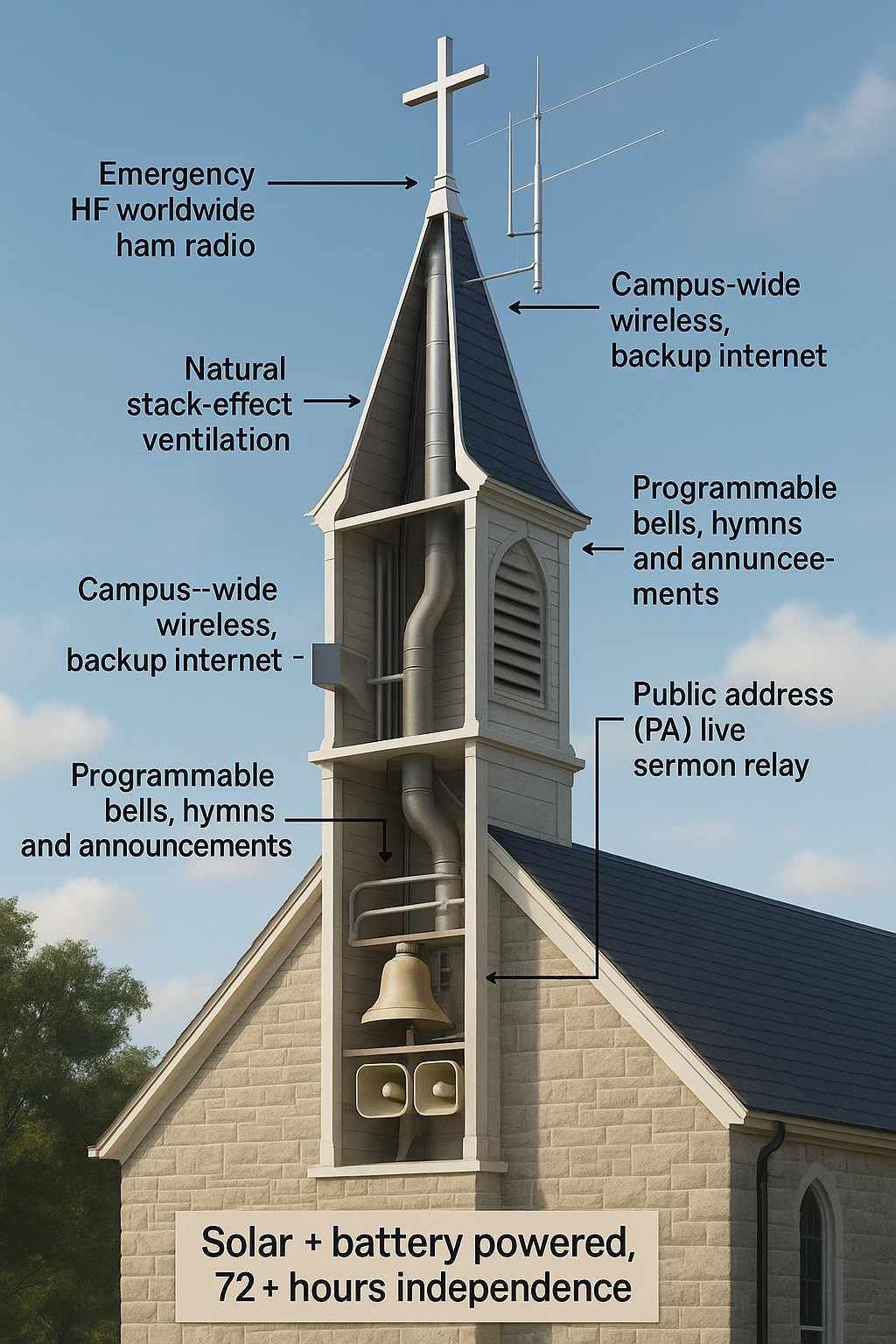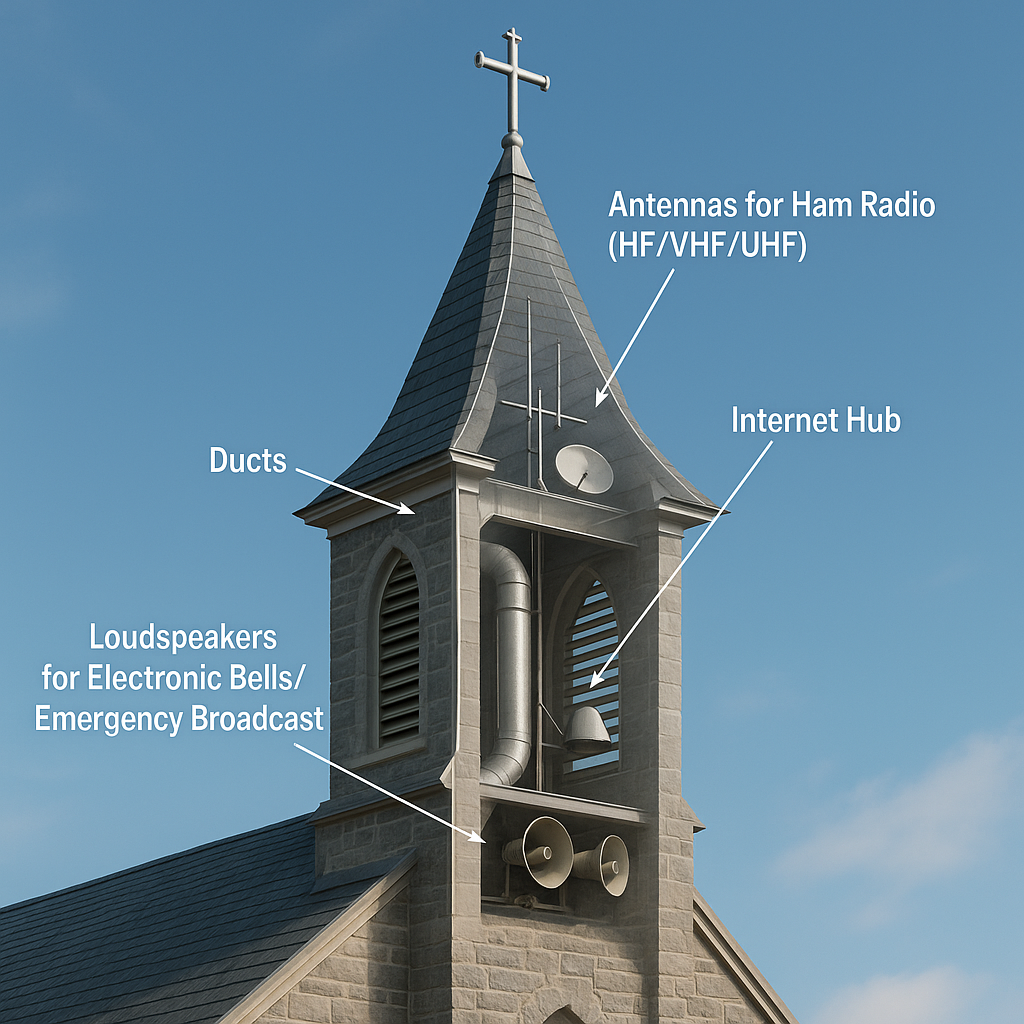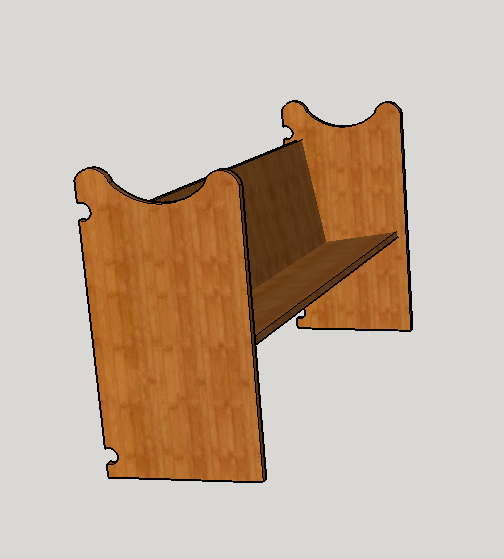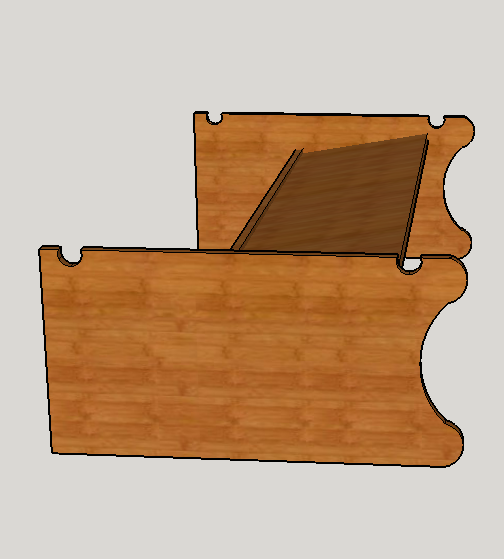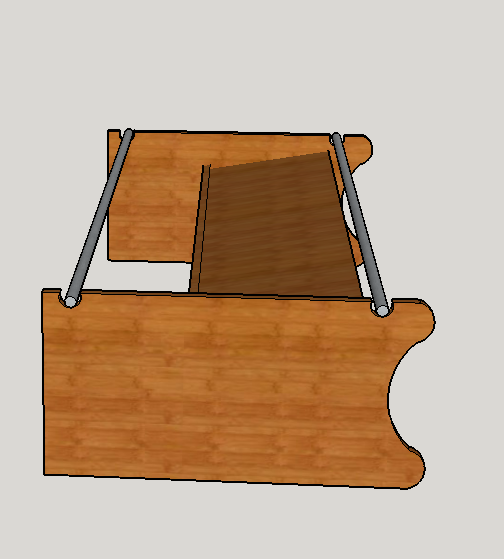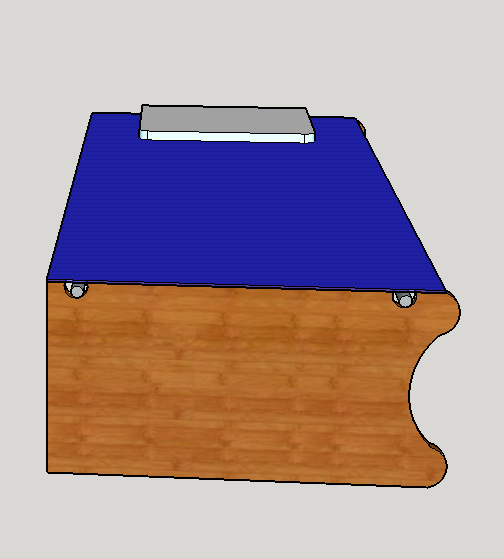Church Sanctuary + Refuge
by North Star Group
Register to share your church's vision with us. We'll connect with you directly to explore ways we can support the success of your project.
Church + Refuge
Executive Summary
For centuries, churches have been sanctuaries—safe places in times of danger. That tradition matters again today, as communities face both natural disasters and modern threats. This project builds on that history while adding practical protection for the people who gather here.
The opportunity: Federal policy now allows churches to access disaster relief and emergency preparedness grants through FEMA and other agencies. This change, implemented in 2018, opened new funding streams for churches willing to incorporate refuge capabilities into their facilities.
Understanding Refuge Requirements
To qualify for this funding, churches must meet specific federal standards for emergency shelter. These requirements vary by location but share common elements designed to protect people during and after disasters.
A refuge is a space built to keep people safe during storms, disasters, or emergencies. Federal guidance (FEMA P-361, ICC 500) describes these areas as strong enough to withstand extreme winds, debris, or other hazards.
Location-Specific Requirements
- Tornado regions: Wind-resistant construction, protective glazing, secure shelter areas
- Flood zones: Elevated safe areas, water-resistant systems
- Urban areas: Security enhancements, surveillance, controlled access
- All locations: 72+ hour self-sufficiency (power, water, communications)
After the Immediate Danger
Once the storm passes or threat subsides, people need short-term support while they recover:
- Clean water and basic food
- Power for lights, communications, medical devices
- Sanitation facilities
- Sleeping areas with reasonable comfort
- Communication with emergency services and family
How We Combine Church + Refuge
The challenge is adding these protective features without losing the sacred feel of the church. Our approach integrates refuge capabilities from the design phase, ensuring the church remains a beautiful place of worship while qualifying for grants that make these features affordable.
Key Principle: Integration from Day One
We design refuge features into the original architecture, engineering, and systems. This approach reduces costs, preserves aesthetics, and ensures grant compliance.
Our Four-Step Implementation Process
We follow a systematic pathway that manages risk and builds confidence at each stage. This stepwise approach ensures nothing is overlooked while keeping your leadership informed and your budget protected.
Why This Process Works
Rather than overwhelming your team with technical complexity upfront, we provide the right information to the right people at the right time. This reduces costs, prevents rework, and ensures everyone stays aligned from concept through completion.
Step 1: Orientation
We start with a no-cost consultation where we listen, collect basic facts, and get to know your church's vision. We gather information on your mission, timeline, budget range, and community needs.
Outcome: A shared understanding of your goals and clarity on whether this project is the right fit for your church.
Step 2: Systems Overview (Leadership Document)
We prepare an overview document in clear, non-technical language for your leadership and funders. This explains the main systems (structure, refuge features, acoustics, communications, energy) backed by preliminary technical analysis to ensure the direction is sound.
- Early HVAC air exchange impacts and acoustic considerations
- Structural load assumptions and energy modeling foundations
- Grant landscape research with strategic funding options
- Financial analysis including investment tax credits and incentive programs
- Designed to be revisable as new information emerges
Outcome: A leadership-ready overview that builds confidence, shows feasibility, and sets the stage for deeper technical work. Includes carefully selected funding opportunities that avoid problematic restrictions on religious activities and property use.
Step 3: Full Technical Package (Professional Document)
With the overview in place, we develop comprehensive technical analysis for the professionals who will design and build. This includes detailed calculations, acoustic sketches, energy models, and compliance notes for federal standards (FEMA P-361, ICC 500) and grant requirements.
- Single, consistent set of instructions for architects, engineers, HVAC vendors, and contractors
- Eliminates duplication of effort, saving time and cost
- Ensures all professionals work from the same specifications
Outcome: A technical playbook that aligns all professionals and prevents costly rework.
Step 4: Grants, Financing & Implementation
With the project defined and documented, we connect it to funding and delivery. We identify and match grant programs, develop realistic timelines tied to funding cycles, and provide contractor-ready documentation for permitting and bids.
Outcome: A clear path from concept to construction—with funding strategy, technical specifications, and community mission all integrated.
The Stepwise Pathway Advantage
Orientation
(free)
Overview
(for leaders)
Technical Package
(for professionals)
Implementation
(funding + delivery)
Investment & Financial Reality
The Bottom Line
In many cases, a refuge-enhanced church costs less than conventional construction when grants are factored in, while providing significantly greater community value and lower operating costs.
Ongoing Operating Benefits
Energy Savings
Solar power + efficient systems typically reduce utility costs by 40-70%
Maintenance Reduction
Structural Insulated Panel (SIP) construction and integrated systems require less ongoing maintenance
Grant Management Income
5-10% of grant awards return to church for managing compliance
What We Provide
Comprehensive Project Development, Not Just Consulting
We provide full project development services from initial concept through construction completion. While we don't take financial risk as general contractors, we coordinate all aspects of design, funding, and construction management to ensure your church is built right for both worship and refuge functions.
Core Services
- Site assessment: Location-specific refuge requirements and grant opportunities
- Systems integration design: Acoustic, structural, mechanical, and electrical coordination
- Grant identification and applications: Federal, state, and foundation funding coordination
- Professional instruction sets: Detailed specifications for architects and engineers
- Compliance management: Ensuring grant requirements are met throughout construction
- Project coordination: Timeline management and milestone tracking
Additional Services
- Property development: Site selection and acquisition assistance
- Contractor coordination: Helping locate and evaluate qualified builders
- Project oversight: Quality assurance and milestone-based development management
- Construction management: Coordinating trades and ensuring compliance throughout build
Our Fees
Our comprehensive project development fees are structured to be reasonable and accessible to churches of all sizes. Additionally, the church receives and manages 5-10% of grant awards as compensation for basic administrative compliance work.
The Result
A worship space that preserves tradition and beauty, while quietly adding refuge capability. Lower operating costs, access to new funding, and a facility ready to serve both spiritual and community needs—everyday and in times of crisis.
Ready to Explore This for Your Church?
Every church's situation is unique. Let's discuss your specific location, community needs, and vision to see how refuge integration could serve your mission.
Architectural & Structural Vision
In collaboration with the Church Sanctuary design team, we have refined a unified vision for a high-efficiency sanctuary that blends sacred-modern design with state-of-the-art construction techniques. Our shared goal is to build upon the existing architectural intent, enhancing it with systems that provide resilience and long-term value.
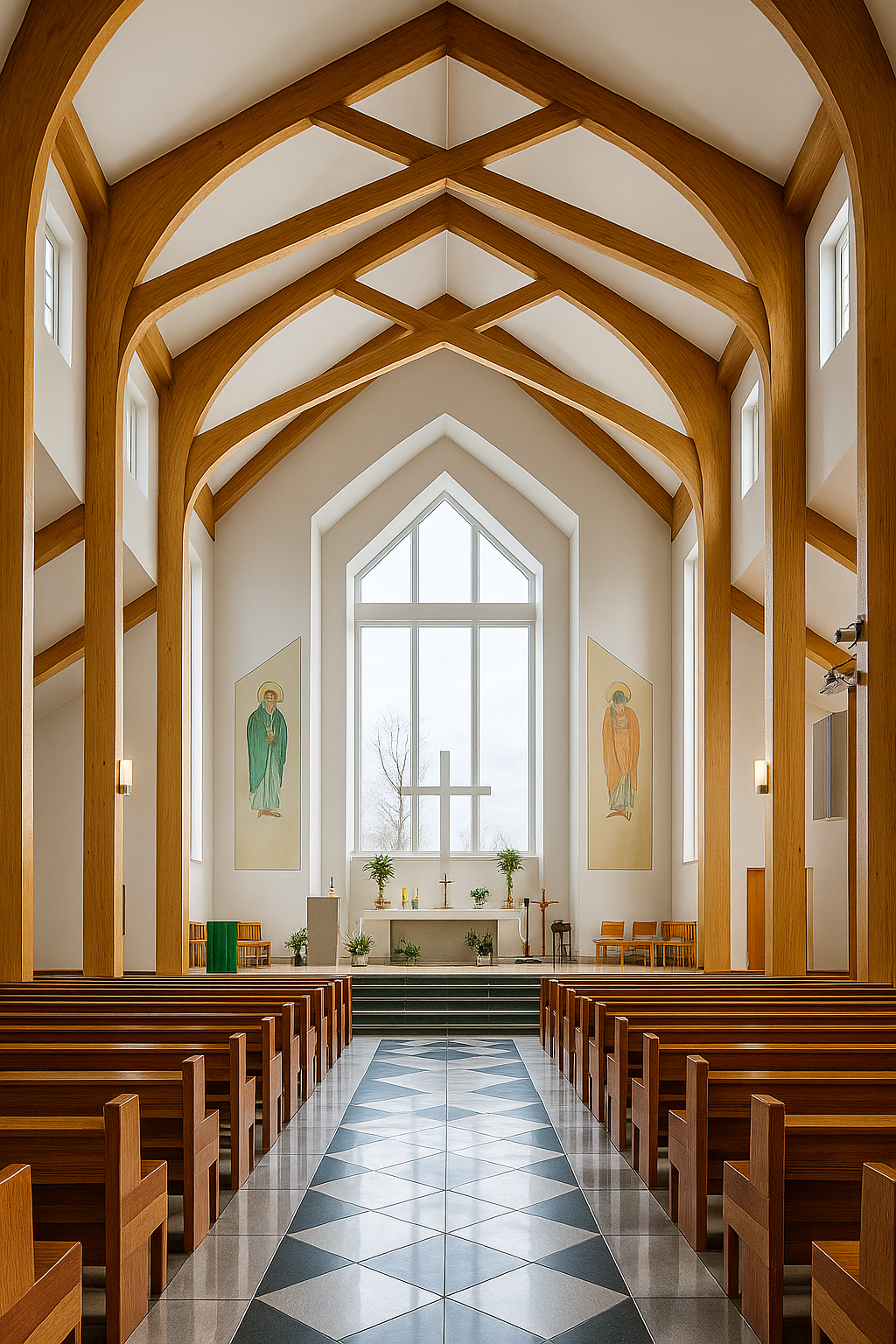
Architectural rendering of the sacred interior with structural design elements.
I. Architectural Vision & Envelope
- Design Intent: A 400-seat sanctuary with vertical sacred symbolism and a hybrid modern-traditional aesthetic.
- Core Philosophy: Emphasis on prefabrication for quality control, efficiency, and speed of installation.
- Wall Assemblies: 6½" to 8¼" Structural Insulated Panels (SIPs) with a minimum R-26 insulation value.
- Roof Assemblies: 10¼"+ SIP roof panels (R-38+) designed to integrate seamlessly with the structural system.
- Foundation: An enhanced conditioned basement plenum that houses all mechanical systems and provides integrated storage and geothermal efficiency.
II. Key Materials & Interior Program
- Structural System: Prefabricated, architectural-grade glulam arch trusses or an approved structural equivalent.
- Exterior Finish: A combination of painted Hardie Plank vertical battens and a cultured stone veneer base.
- Interior Spaces: Sanctuary, Foyer, Pastor's Office, Nursery/Bridal Suite, and Restrooms.
- Interior Finishes: LVT flooring, porcelain tile in wet areas, and stained-grade wood finishes on exposed structural elements.
- Aesthetic Elements: Gothic-style window units and an optional prefabricated steeple.
Advanced SIP Technology for Demanding Spans
The sanctuary's design, with its beautiful, open interior, involves long roof spans that require an advanced approach to structural integrity. To meet these demands efficiently, we utilize our patent-pending **FIRM (Fully Integrated Reinforced Modular SIP) system**. This method embeds structural reinforcement directly into the SIP core, allowing us to achieve the necessary strength for long spans without relying on bulky secondary framing, thus preserving the open, sacred aesthetic.
Further technical details and specifications for this proprietary system are available upon request.
III. Hardened Basement Plenum - Community Storm Shelter
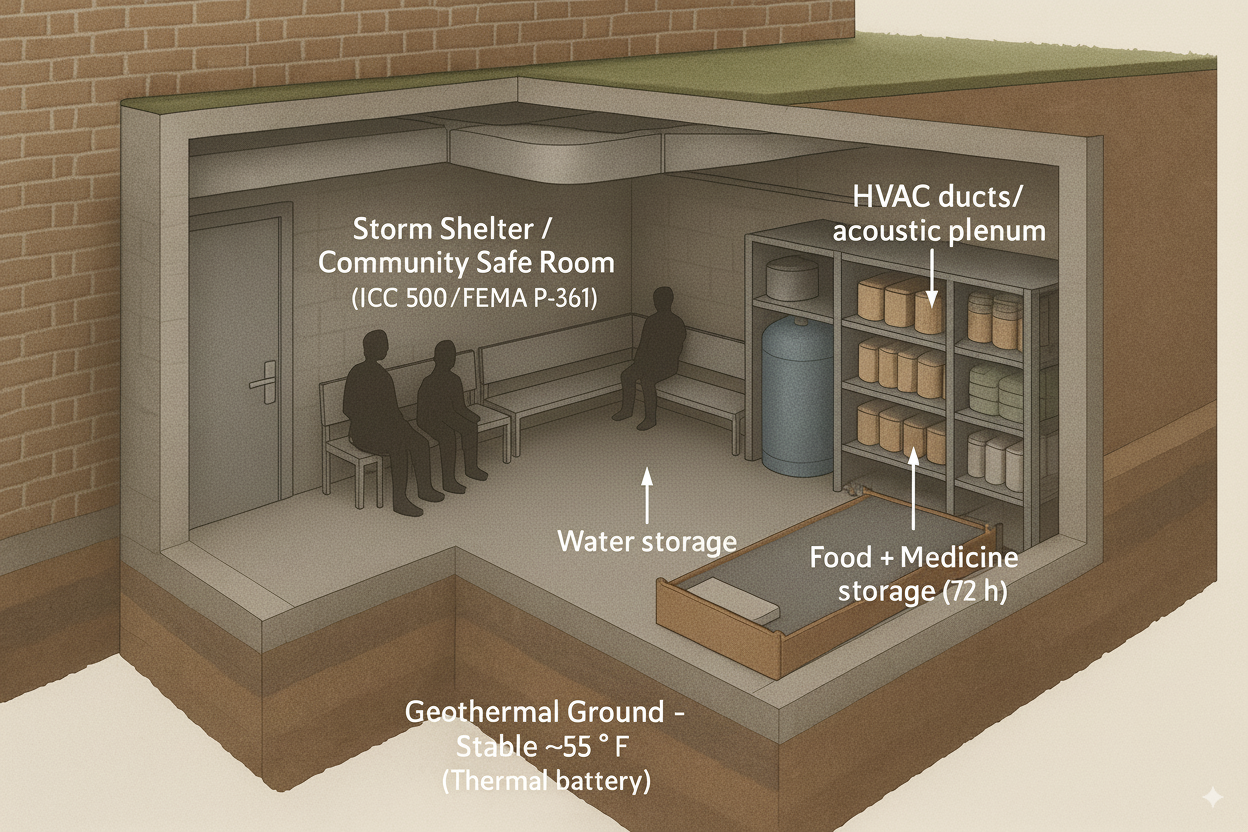
Multi-purpose basement design integrating storm shelter, mechanical systems, and emergency supply storage.
The basement plenum serves multiple critical functions: housing mechanical systems for efficient building operation, providing ICC 500/FEMA P-361 compliant storm shelter for up to 100 community members, and supporting the building-integrated acoustic design through strategic HVAC duct placement. This tri-purpose approach maximizes infrastructure investment while creating genuine community resilience capability.
Structural Protection
- 250 mph wind resistance: Reinforced concrete walls and ceiling
- Impact protection: Tested to ICC 500 missile impact standards
- Foundation integration: Continuous load path verification
- Safe room signage: FEMA-compliant marking and identification
Occupant Capacity
- Floor area: Minimum 5 ft² per person (500+ ft² usable)
- Accessibility: Wheelchair spaces and ADA-compliant access
- Headroom: 7+ feet clearance throughout shelter area
- Bench seating: Comfort during extended severe weather events
Life Safety Systems
- Impact-rated doors: Three-point latch, outward swinging
- Protected ventilation: 200+ in² free area with debris baffles
- Emergency exits: Two egress paths for 50+ occupants
- Communication systems: Integration with sanctuary emergency systems
Emergency Provisions
- Water storage: 1,500-2,000 gallon capacity (72+ hours)
- Food supplies: FEMA HDRs/MREs for 100-150 occupants
- Medical storage: Refrigerated unit with backup power
- Sanitation: Municipal connection with emergency backup
System Integration Benefits
Acoustic Integration
HVAC ducts serve as acoustic plenum, supporting building-integrated sound design
Energy Efficiency
Geothermal thermal battery (~55°F) reduces HVAC loads year-round
Emergency Power
Solar + battery systems provide 72+ hour autonomy for shelter operations
Community Resilience
Dual-level emergency capability: storm shelter below, displacement accommodation above
A Note on Material Sourcing & Value Engineering
For all specified materials and systems, including the structural trusses, roofing, and finishes, we are committed to a thorough sourcing process. We will diligently research and present the best available options to ensure the optimal mix of aesthetic quality, long-term durability, and cost-effectiveness for the sanctuary.
Acoustic Design Process
Acoustic Executive Summary
This chapel design treats the building structure itself as the primary acoustic system, minimizing the need for extensive sound treatments or costly electronic systems. The design process uses computational modeling to test how sound will behave in the space *before* finalizing structural details, aiming for natural sound quality appropriate to worship while leaving flexibility for targeted enhancements.
Design Process
- Computational Modeling: Test voices and music to identify issues early.
- Analysis of Building Elements: Evaluate the acoustic contribution of each component.
- Design Refinement: Adjust geometry based on modeling results.
- Professional Validation: Engage a licensed acoustician to review and validate the approach.
- Final Structural Design: Proceed with engineering after acoustic validation.
Architectural Elements with Acoustic Functions
- Basement Plenum: Acts as a large-volume bass management system.
- Variable Wall Thickness: Creates subtle sound diffusion effects.
- Decorative Grilles: Serve dual ventilation and acoustic functions.
- Steeple Base Geometry: Contributes to sound distribution.
Key Deliverables
- Design Framework: Building geometry options optimized for acoustic performance.
- Validated Specifications: Professional review and recommendations from an acoustician.
- Performance Predictions: Expected acoustic measurements (RT60, STI).
- Construction Details: Critical instructions for builders on acoustic elements.
Risk Considerations
Starting construction without this analysis risks poor speech intelligibility and the need for expensive retrofit sound systems, negating the benefits of an integrated design.
Technical Appendix & Modeling Methodology
For a detailed review of the computational models, custom algorithms, and physics principles guiding our building-integrated acoustic strategy, please download the full technical document.
View Building-Integrated Acoustic Design White Paper (PDF)Innovation in Furnishings: The Convertible Pew
A key innovation enabling the sanctuary's dual-use capability is patent-pending convertible seating technology. This system allows traditional church seating to transform into sleeping accommodations, eliminating the need for separate cot storage and complex logistics while preserving the sacred aesthetic of the sanctuary during regular worship.
Selected Manufacturing Partner
Kivett’s Inc. — Family-Owned Since 1958
For more than six decades, Kivett’s has crafted durable, beautiful church seating trusted across the Southeast. Their Clinton, North Carolina facility brings heritage woodworking and modern production together — an ideal fit for our patent-pending convertible pew. Partnering with Kivett’s helps us preserve the dignity of sacred spaces during worship while enabling practical emergency preparedness when communities need it most.
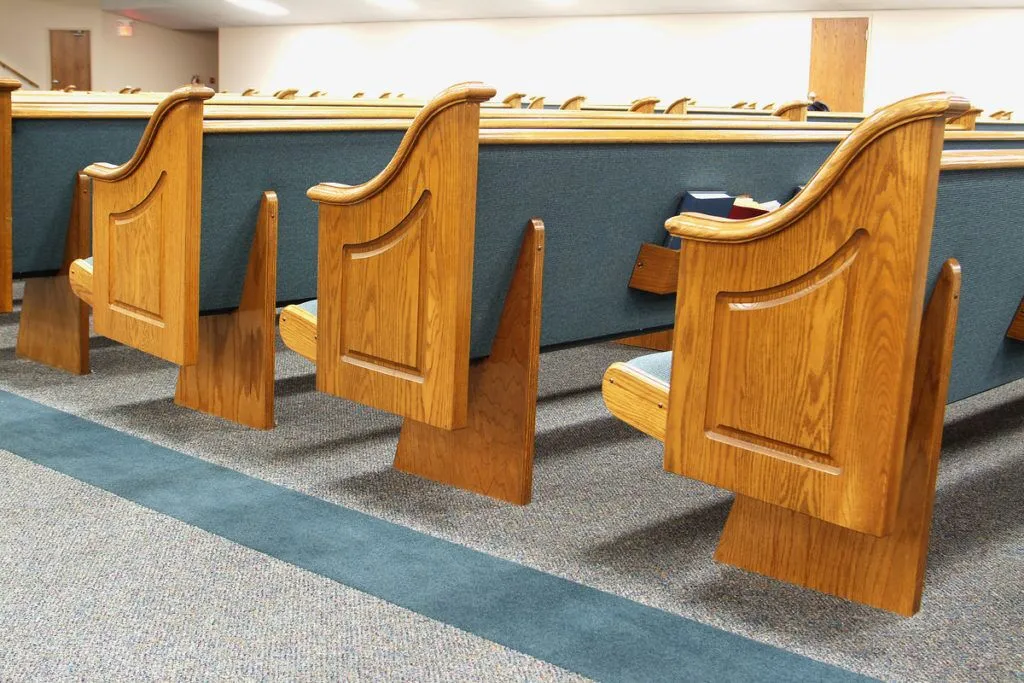
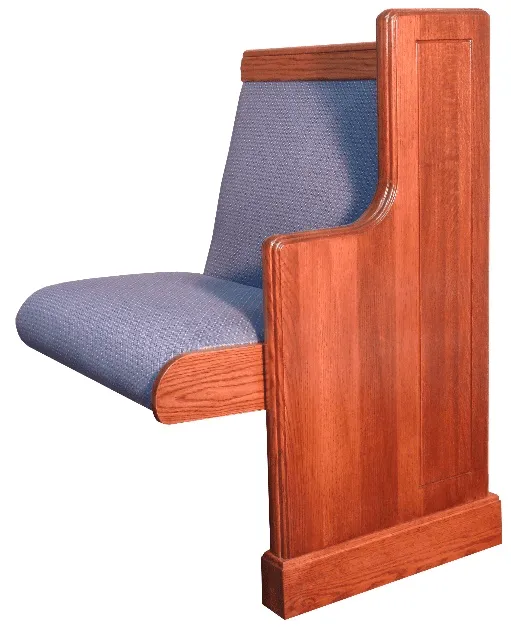
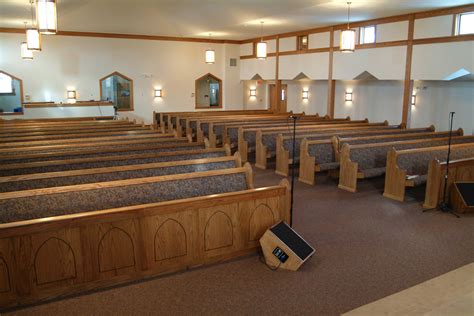
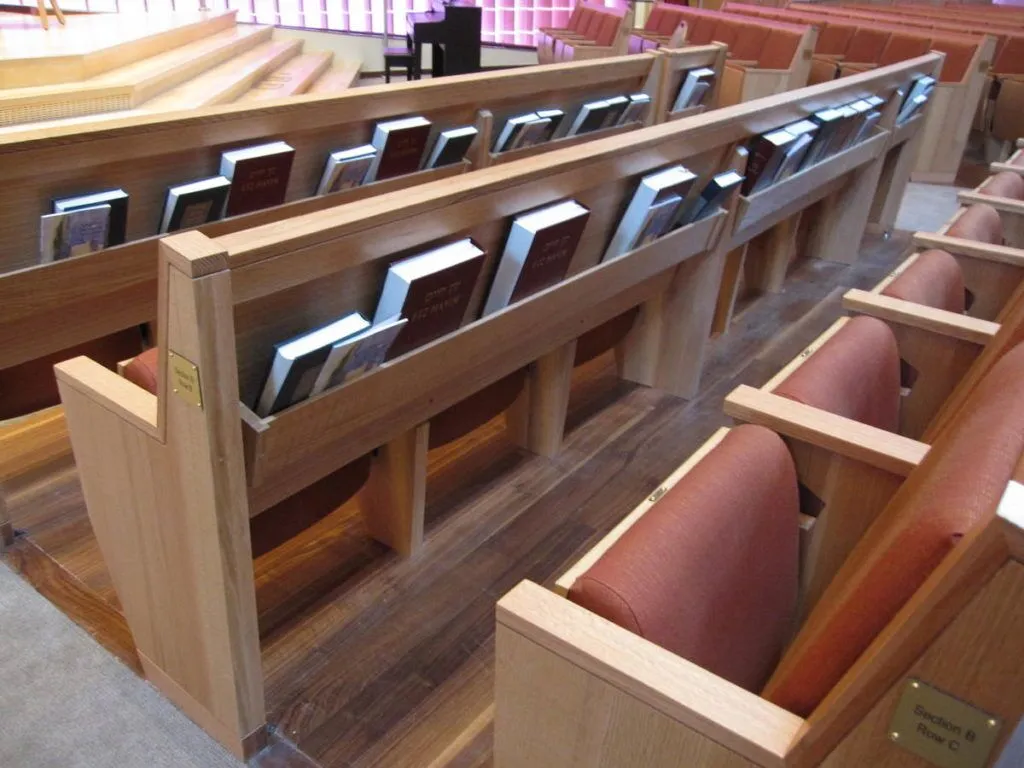
Manufacturing Excellence
In-house production in Clinton, NC with solid oak construction methods and modern comfort features.
Craftsmanship + Innovation
Heritage woodworking that integrates with our convertible mechanism while preserving traditional aesthetics.
Delivery & Installation
Complete design, manufacturing, delivery, and installation services with regional sales coverage.
Regional Contact — Eastern Territory
Kivett’s supports congregations nationwide. For manufacturing partnerships or scheduling, contact Craig directly.
Convertible Seating Technology
Core Innovation Features
🛠️ Dual-Purpose Design
Traditional church seating that transforms into emergency sleeping accommodations without compromising aesthetic or functional requirements.
⚡ Rapid Deployment
Quick conversion capability allowing trained personnel to deploy emergency shelter capacity efficiently when community needs arise.
🏗️ Structural Integration
Designed to work seamlessly with sanctuary architecture while providing durable, comfortable emergency accommodation.
📋 Simplified Logistics
Eliminates need for separate cot storage and complex emergency equipment logistics while maintaining professional shelter capability.
View the Provisional Patent Application
For complete technical specifications, detailed claims, and engineering drawings, the full provisional patent application is available for review.
View Full Patent Document (PDF)Grant Funding Strategy
Total Pipeline
$3.05M
Target Recovery
$1M – $3M
Key Sources
HUD ESG, FEMA NSGP,
Solar ITC, USDA CF, CDBG
Potential Grant Opportunities
| Grant Source | Purpose / Fit | Est. Range | Notes |
|---|---|---|---|
| HUD ESG | Emergency shelter conversion via pews | $81K – $14.6M | Average $795K; supports retrofit projects and larger conversions |
| FEMA NSGP | Preparedness/emergency use (supplemental) | $150K – $250K | FY 2024: $454.5M total; FY 2025: $274.5M projected |
| FEMA HMGP | Storm shelter / ICC 500 compliance | 6–7 figures | Requires state coordination, major resilience fit |
| Solar Investment Tax Credit (ITC) | Integrated solar roof | 30% of install | Transferable if church cannot monetize directly |
| Duke Energy / NC Energy Saver | HVAC/plenum efficiency rebates | $50K – $100K | Applies to geothermal & 24V lighting |
| ZSR Foundation | Community resilience & capital support | $100K – $300K | State philanthropic partner |
| USDA Community Facilities | Community-serving facility upgrades | $100K – $500K | Eligible for rural-serving churches |
| HUD CDBG | Facility improvement / emergency shelter | $50K – $250K | Dependent on municipal participation |
| DOE Energy Efficiency Grants | Lighting and HVAC retrofits | $50K – $200K | Applies to 24V DC lighting strategy |
| Private Faith-Based Foundations | Capital campaigns / resilience projects | $50K – $500K | Ex: Lilly Endowment, Duke Endowment |
| State Resilience Funds | Storm hardening, energy resilience | $100K – $400K | Emerging state-level climate/resilience programs |
Together these programs form a diversified funding stack: federal resilience, renewable energy incentives, state/local funds, and private philanthropy. Layered correctly, they reduce net cost while maintaining mission alignment.
Recovery Scenarios & Net Cost
| Scenario | Grant Recovery | Estimated Net Cost |
|---|---|---|
| Low-End | $882,000 | $2,572,727 |
| Realistic | $1,500,000 | $1,954,727 |
| High-End | $3,000,000 | $454,727 |
Net cost estimates are based on an all-in project cost of ~$3.45M, as outlined in the Executive Summary.
Site Analysis & Development Considerations
Critical Planning Phase
Proper site analysis is essential before any church development project. Understanding zoning requirements, utility access, and regulatory constraints early prevents costly delays and ensures your refuge-enhanced church can be built as designed.
Zoning & Legal Requirements
- Current zoning classification and permitted uses
- Conditional use permit requirements for religious facilities
- Emergency shelter provisions as accessory use
- Building height restrictions and exceptions for steeples
- Setback and buffer requirements from adjacent properties
- RLUIPA protections against discriminatory restrictions
Physical Site Characteristics
- Topography and slope analysis for drainage and access
- Soil conditions and bearing capacity for foundation design
- Flood zone designation and elevation requirements
- Environmental hazards or contamination concerns
- Easements and right-of-way restrictions
- Natural features requiring preservation
Access & Infrastructure
- Utility availability: water, sewer, electric, gas
- Connection costs and capacity assessments
- Road access and traffic patterns for Sunday services
- Emergency vehicle access requirements
- Public transportation accessibility
- Telecommunications infrastructure for modern needs
Development Capacity
- Maximum building footprint and floor area ratio
- Parking requirements: typically 1 space per 3-4 seats
- Impervious surface limitations and landscaping requirements
- Future expansion potential within zoning constraints
- Stormwater management obligations
- Green space and buffer requirements
Additional Considerations for Refuge Integration
Enhanced Requirements
- Emergency generator placement and noise considerations
- Additional parking for refuge capacity beyond normal worship
- Enhanced utility capacity for extended occupancy periods
- Emergency access routes and circulation patterns
Regulatory Coordination
- Emergency management agency coordination for shelter designation
- Building code compliance for dual-use facilities
- Fire department review of emergency plans and access
- Health department requirements for food service and sanitation
Our Site Analysis Process
Research & Documentation
Comprehensive review of zoning, utilities, and regulatory requirements
Site Assessment
Physical evaluation of topography, access, and development constraints
Development Strategy
Integration plan balancing church needs, refuge requirements, and regulations
This thorough analysis ensures your project moves forward without costly surprises or regulatory delays, setting the foundation for successful church and refuge integration.
Site Analysis & Development Considerations
Critical Planning Phase
Proper site analysis is essential before any church development project. Understanding zoning requirements, utility access, and regulatory constraints early prevents costly delays and ensures your refuge-enhanced church can be built as designed.
Zoning & Legal Requirements
- Current zoning classification and permitted uses
- Conditional use permit requirements for religious facilities
- Emergency shelter provisions as accessory use
- Building height restrictions and exceptions for steeples
- Setback and buffer requirements from adjacent properties
- RLUIPA protections against discriminatory restrictions
Physical Site Characteristics
- Topography and slope analysis for drainage and access
- Soil conditions and bearing capacity for foundation design
- Flood zone designation and elevation requirements
- Environmental hazards or contamination concerns
- Easements and right-of-way restrictions
- Natural features requiring preservation
Access & Infrastructure
- Utility availability: water, sewer, electric, gas
- Connection costs and capacity assessments
- Road access and traffic patterns for Sunday services
- Emergency vehicle access requirements
- Public transportation accessibility
- Telecommunications infrastructure for modern needs
Development Capacity
- Maximum building footprint and floor area ratio
- Parking requirements: typically 1 space per 3-4 seats
- Impervious surface limitations and landscaping requirements
- Future expansion potential within zoning constraints
- Stormwater management obligations
- Green space and buffer requirements
Additional Considerations for Refuge Integration
Enhanced Requirements
- Emergency generator placement and noise considerations
- Additional parking for refuge capacity beyond normal worship
- Enhanced utility capacity for extended occupancy periods
- Emergency access routes and circulation patterns
Regulatory Coordination
- Emergency management agency coordination for shelter designation
- Building code compliance for dual-use facilities
- Fire department review of emergency plans and access
- Health department requirements for food service and sanitation
Our Site Analysis Process
Research & Documentation
Comprehensive review of zoning, utilities, and regulatory requirements
Site Assessment
Physical evaluation of topography, access, and development constraints
Development Strategy
Integration plan balancing church needs, refuge requirements, and regulations
This thorough analysis ensures your project moves forward without costly surprises or regulatory delays, setting the foundation for successful church and refuge integration.
Roofing & Integrated Solar System
The Integrated Solar Roof Concept
Rather than a traditional roof with separately mounted solar panels, this proposal integrates the solar generation directly into the roofing material itself. This approach transforms the entire chapel roof into a discreet, high-performance energy generation system that maintains the aesthetic integrity of the sacred architecture.
Recommended Technology: GAF Timberline Solar™
The GAF Timberline Solar™ shingle is the recommended solution. It is the world's first nailable solar shingle, which allows it to be installed with the same methods as a traditional asphalt shingle roof. This simplifies installation, reduces costs, and ensures a durable, weather-tight seal, all while providing significant power generation.
- Power Output: 57W per shingle from monocrystalline PERC solar cells.
- Durability: Carries a 25-year warranty and is rated for 130 mph winds.
- Installation: Nailable design allows for installation by any GAF-certified roofer.
- Aesthetics: Blends seamlessly with traditional asphalt shingles for a uniform look.
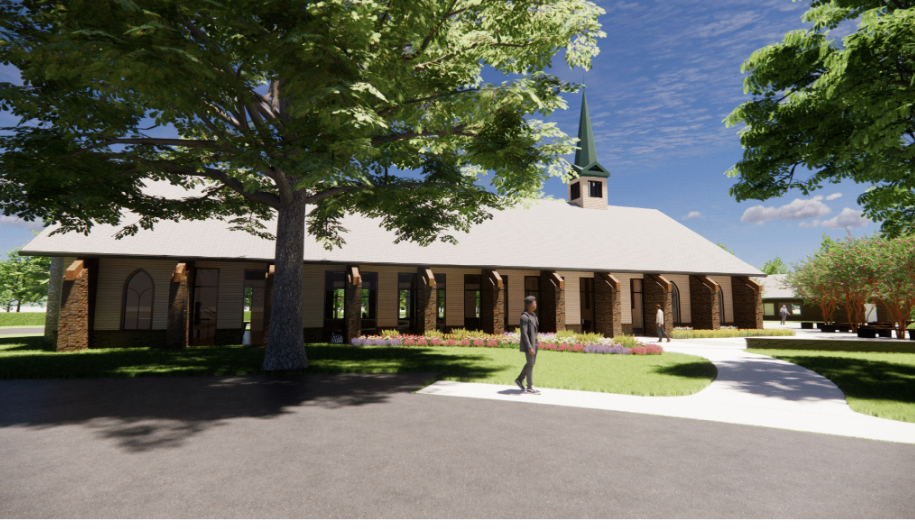
The integrated solar roof maintains the chapel's traditional aesthetic.
Power Generation Potential for Church Sanctuary
Chapel Roof Area: Approximately 6,510 sq ft
Estimated Usable Solar Area: ~5,500 sq ft
GAF Timberline Solar Scenario
- System Capacity: ~1,100 shingles × 57W = ~63 kW system
- Annual Production: ~82,000 - 95,000 kWh
- Emergency Power: 48+ hours of independence (with compatible battery storage).
- Potential: Can cover all chapel operations plus provide significant emergency reserve capacity.
Note: These are preliminary estimates. A professional solar assessment is required for a final, precise projection.
HVAC + Plenum Systems
Advanced Conditioned Plenum with Geothermal Integration
The conditioned basement plenum leverages North Carolina's consistent ground temperatures (45-55°F) to provide highly efficient climate control. This system combines centuries-old root cellar technology with modern geothermal engineering, dramatically reducing both heating and cooling loads by using the earth's stable temperature as a starting point.
🌡️ Geothermal Efficiency
- Reduces annual HVAC energy costs by 50-70%.
- Leverages stable ground temperatures for both heating and cooling.
- Significantly smaller HVAC equipment required (36% load reduction).
- Qualifies for substantial energy efficiency grants and incentives.
🔇 Ultra-Quiet Operation
- All mechanical equipment is housed in the isolated basement plenum.
- Oversized plenum allows for ultra-low air velocity, eliminating noise.
- Engineered for a target noise level of <25 dB (inaudible library quiet).
- Vibration isolation prevents sound transmission through the structure.
🛡️ Emergency Reliability
- Maintains a livable 50-60°F comfort zone even during a power outage.
- Protects generators and batteries in a secure, conditioned space.
- Provides ideal cool-storage conditions for emergency food and water.
- Reduced power load allows for longer runtime on emergency generators.
A Proven, Reliable Technology
Underground plenum and earth tube systems are not experimental; they are proven technologies used in high-performance commercial buildings worldwide, including the EPCOR Tower in Edmonton and the LEED Platinum certified Earth Rangers Centre in Toronto, to achieve significant, long-term energy savings.
System Monitoring & Partnership
To ensure optimal performance and long-term reliability, the HVAC and plenum systems will be tied into a comprehensive Building Automation System (BAS). We will coordinate with the Church Sanctuary-selected energy partner, "Power of Clean Energy", to integrate the geothermal system's monitoring data, providing real-time insights into energy savings and predictive maintenance alerts.
24V DC Lighting Systems
Marine-Grade 24V DC LED Lighting
24V DC lighting systems are proven technology in recreational vehicles, boats, and off-grid applications where safety, efficiency, and reliability are paramount. Churches should embrace this technology for its superior safety profile, reduced electrical requirements, and exceptional emergency performance capabilities.
Key Advantages
- Ultra-safe: Eliminates electrocution risk
- No licensed electrician required for maintenance
- 50% more efficient than 12V systems
- Seamless battery backup integration
- Smaller, more aesthetic fixtures
24V DC Lighting System
Marine-grade safety and efficiency
Why 24V DC is Superior for Churches
🛡️ Ultimate Safety
No Electrocution Risk: 24V cannot cause harmful shock
Safe for children, elderly, and wet conditions
Fire Safety: Dramatically reduced fire risk
Low voltage minimizes arc and spark potential
Water Safe: System won't short circuit in water
Essential for baptismal areas and emergency use
🔧 Installation Advantages
No Licensed Electrician Required: For maintenance and modifications
Church volunteers can safely work on system
No Conduit Required: Simplified installation
Class 2 wiring doesn't need junction boxes
Easier Maintenance: Less disruptive to occupants
Repairs during services if needed
⚡ Technical Efficiency: 24V vs 12V
12V System Efficiency:
Only 75% of electrical energy used for light
25% wasted as heat in resistors
24V System Efficiency:
88% of electrical energy used for light
Only 12% wasted as heat
The Result:
**50% reduction in electrical waste**
Lower current draw, thinner wires needed
Proven Applications & Examples
🚢 Marine & RV Industries
Boats and RVs have used 24V DC lighting for decades because of harsh conditions and safety requirements:
- **Watt-a-Light Marine Systems:** Complete 24V lighting for boats with "More Light, Less Watts"
- **CLEANLIFE Systems:** Residential 24V DC systems converting entire homes
- **Marine flood lights:** 10W producing 1,150 lumens for security lighting
- **Tube lighting:** 4-foot T8 LED replacements at 24V DC
🏢 Commercial Applications
Low voltage lighting is becoming standard in many commercial settings:
- **Landscape lighting:** 12V/24V systems standard for outdoor applications
- **Power over Ethernet (PoE):** Hospitality industry adopting for efficiency
- **Security systems:** All surveillance and access control uses low voltage
- **Smart buildings:** IoT devices require low voltage infrastructure
Industry Reality: If 24V DC is safe enough for boats in salt water and RVs on the road, it's certainly appropriate for churches. The technology is mature, reliable, and proven in demanding environments.
Emergency Power Integration
🔋 Seamless Battery Backup
- Direct DC Connection: No inverter losses - batteries directly power lights
- Extended Runtime: 24V systems draw half the current of 12V
- Solar Integration: Solar panels naturally produce DC power
- Emergency Duration: Hours instead of minutes of backup lighting
⚡ Power Efficiency Benefits
- Lower Current Draw: 24V draws half the amps of 12V for same power
- Thinner Wiring: Reduced copper requirements and installation costs
- Voltage Drop Resistance: Better performance over long runs
- Heat Reduction: Less waste heat means cooler operation
Design and Aesthetic Advantages
✨ Beautiful, Smaller Fixtures
24V LED fixtures are dramatically smaller than 120V equivalents because they don't need bulky transformers, heat sinks, or large lamp housings. This enables:
- Hidden fixtures that don't distract from architecture
- Delicate pendant lights and chandeliers previously impossible
- Recessed lighting with minimal ceiling penetration
- Flexible strip lighting for indirect illumination
🎨 Design Flexibility
Low voltage systems offer superior design options:
- Precise dimming and color control
- Easy relocation of fixtures without electrician
- Creative lighting arrangements not possible with 120V
- Integration with smart building systems
💡 Light Quality and Performance
Equivalent Lumens, Superior Efficiency
Modern 24V LED systems produce identical light output to traditional systems:
- 7W LED = 1,000+ lumens (equivalent to 60W incandescent)
- 20W flood light = 2,200+ lumens for security lighting
- 4-foot tube = 2,400+ lumens for general illumination
🌈 Superior Color Quality
LED technology provides better color rendering than traditional church lighting, with CRI >80 and options from warm 2700K to daylight 5000K.
⏱️ Exceptional Longevity
50,000+ hour lifespan means 25+ years of typical church use with minimal maintenance - perfect for hard-to-reach cathedral ceilings.
Light Quality Comparison
24V LED vs Traditional Lighting
24V LED Performance
24V DC System Components
🔌 Power Supply and Distribution
- Central 24V DC power supplies with battery backup
- Individual zone control for flexible lighting scenes
- Smart dimming controls compatible with building automation
- Emergency battery systems with automatic switchover
- Solar panel integration for daytime charging
💡 Fixture and Control Options
- Recessed ceiling fixtures (3W-15W range)
- Pendant and chandelier-style fixtures
- Linear strip lighting for indirect illumination
- Flood lights for exterior and security applications
- Smart controls with smartphone app integration
Implementation and Code Compliance
Code Compliance
UL Listed Class 2 systems meet NEC requirements for low voltage installations
Installation Flexibility
No conduit required, easier scheduling, volunteer-friendly maintenance
Future-Proof Design
Compatible with smart building systems and renewable energy integration
Integrated Power Systems
Energy Independence Through Cumulative Efficiency
Our integrated approach combines the GAF solar roof, battery storage, and a backup generator with the inherent efficiencies of 24V DC lighting and the geothermal plenum. Each efficiency compounds upon the others, dramatically reducing the building's overall power requirements and enabling complete energy independence during emergencies.
☀️ Solar Power Generation
- The GAF Timberline Solar™ roof provides a ~63 kW generation system.
- Produces 82,000-95,000 kWh annually, covering all chapel energy needs.
- Excess power is sold back to the grid, creating an ongoing revenue stream via net metering.
🔋 Battery Storage
- Provides 48-72+ hours of power for critical systems during an outage.
- 24V lighting connects directly to batteries, eliminating DC-to-AC conversion losses.
- Reduced building loads allow for a smaller, more cost-effective battery system.
⚙️ Generator Backup
- Generator is housed in the secure, sound-isolated, and conditioned basement plenum.
- Reduced electrical loads enable a smaller, more fuel-efficient generator.
- Provides long-term power for extended outages when solar generation may be limited.
Calculated Power Savings
The cumulative effect of these integrated systems results in a ~36% reduction in the building's peak electrical demand compared to a traditional design.
Amperage Reduction
215-230 amps less
Annual Cost Savings
$6,220 – $6,680
Peak Demand Reduction
51-54 kW less
This reduced demand allows for smaller transformers, thinner wiring, and right-sized backup systems, creating substantial infrastructure cost savings.
Water + Plumbing
Dual-System Water & Waste Management
Municipal utilities serve daily operations with robust emergency backup systems providing 72+ hour independence during disasters. Private well and large-scale holding tank technology ensures continuous water supply and waste management for 100-150+ emergency shelter occupants.
System Advantages
- Municipal reliability with emergency independence
- Proven holding tank technology (like cruise ships/RV parks)
- FEMA-compliant shower facilities
- Gas-fired emergency hot water (power-outage ready)
Emergency Capacity
💧 Water Supply Systems
Primary: Charlotte Water Municipal
Service: 2101 Carmel Rd, Charlotte, NC 28226
Contact: (704) 336-7600
Use: Daily operations, worship services
Emergency: Private Well + Storage
Storage: 1,500+ gallon basement tank
Capacity: 72+ hours for 100-150+ people
Switching: Automatic when municipal fails
💡 Emergency Water Calculations
Recommended: 1,500+ gallon capacity for safety margin
🚽 Waste Management Systems
Primary: Municipal Sewer
Service: Daily waste management
Verification: Confirm availability at address
Use: Normal operations
Emergency: Underground Holding Tank
Size: 12,000-15,000 gallon capacity
Operation: Valve-switched during emergencies
Service: Professional pump-out as needed
🌍 Proven Technology Applications
💰 Estimated Investment
Pump-Out Service: $300-500 per service (as needed)
Monitoring Equipment: $2,000-5,000
Significantly less than full septic system design/permitting
🚿 Bathroom Facilities
📋 FEMA Standards Compliance
ADA Requirement: 1 out of every 6 showers must be handicap accessible
For 100-150 people: 4-6 showers required (1 ADA minimum)
Proposed Design: 4 showers (2 regular + 2 handicap) - meets baseline and exceeds ADA requirements
2 Regular Showers
2 Handicap Showers
🔥 Hot Water Systems
⚡ Daily Use: Tankless System
- 2-3 electric tankless units
- On-demand heating efficiency
- Adequate for worship/meeting use
- Basement plenum location
🔥 Emergency: Large Gas Tank
- 500+ gallon gas-fired heater
- Natural gas or propane fuel
- Functions during power outages
- Hot water for 100-150+ people
🔗 System Integration
Emergency Mode: Large gas tank provides high-capacity hot water
Integration: Water storage systems coordinate with basement plenum design detailed in HVAC + Plenum Systems
🔧 Maintenance & Next Steps
Annual Requirements
- Well water quality testing
- Holding tank inspection
- Gas system safety check
- Emergency switching test
- Code compliance review
Immediate Next Steps
- Call Charlotte Water (704) 336-7600
- Well placement site survey
- Holding tank sizing/location
- Mecklenburg County permits
- Emergency switching design
Food + Refrigeration
Dual-Approach Food Service Strategy
Emergency-first design using shelf-stable MREs (Meals Ready-to-Eat) stored in the temperature-controlled basement plenum, combined with a modest kitchen facility for daily operations, events, and extended shelter periods. System prioritizes reliability and simplicity while meeting FEMA emergency feeding standards.
System Advantages
- MREs require no refrigeration or complex preparation
- Basement plenum provides ideal cool storage conditions
- Modest kitchen supports daily use and events
- Medical refrigeration for essential medications
Emergency Food Capacity
🥫 Emergency Food Storage (Primary Strategy)
MRE (Meals Ready-to-Eat) Storage System
Storage Requirements
- Quantity: 100-150 people × 3 days = 300-450 HDRs (Humanitarian Daily Rations)
- Location: Basement plenum (55-65°F ideal)
- Packaging: Each HDR = full day's food supply (2,200+ calories)
- Rotation: 3-year shelf life, annual inspection
HDR Advantages
- Used by FEMA in actual disasters
- No cooking/preparation needed
- One HDR = complete daily nutrition
- Acceptable to diverse religious/dietary groups
- Cost ~$6-8 each (vs $15+ for military MREs)
- Air-drop survivable packaging
FEMA Official Standards
📊 Storage Space Calculations
Storage space needed: ~80-120 cubic feet (basement plenum ideal)
Cost estimate: $1,800-3,600 for complete 72-hour supply
Annual replacement: ~33% rotation = $600-1,200/year
🍳 Modest Kitchen Facility (Secondary/Event Use)
Extended Break Room / Event Kitchen
Equipment & Layout
- Refrigerator: Commercial-grade for staff/medicines
- Induction cooktops: Energy-efficient, no gas required
- Convection oven: Lower power consumption
- Microwave: Quick heating for staff meals
- Prep counter: Sandwich making, basic food prep
- Storage cabinets: Utensils, plates, basic supplies
Ventilation Design
- Basement location: Isolated from worship space
- Exhaust system: Direct exterior venting
- Air filtration: Prevent odors reaching sanctuary
- Separate HVAC zone: Independent climate control
- Fire suppression: Kitchen-grade safety systems
Multi-Purpose Use Cases
Events: Wedding receptions, church dinners, community meals
Emergency Extended: Hot meal preparation when MRE supplies run low
Recovery: Meal prep for disaster relief workers and volunteers
⚡ Kitchen Power Requirements
Convection oven: 5kW (240V) - faster cooking, lower power than standard
Refrigerator: 2kW (120V) - continuous operation essential
Total peak load: ~10.5kW (manageable with solar + battery backup)
💊 Medical Refrigeration
Essential Medication Storage
Requirements
- Temperature: 36-46°F (2-8°C) precise control
- Backup power: Battery/generator backup essential
- Monitoring: Temperature alarms and logging
- Security: Locked storage for controlled substances
- Capacity: Insulin, emergency medications for 100-150+ people
Equipment Options
- Pharmaceutical refrigerator: Medical-grade unit
- Dual power: AC power + DC battery backup
- Digital monitoring: WiFi alerts for temperature
- Separate from food storage: Contamination prevention
- Cost: $2,000-5,000 for proper medical unit
🛡️ Food Safety & Compliance
Health Department Compliance
- Mecklenburg County health permits
- Commercial kitchen standards (if cooking)
- Food handler certifications
- Regular inspections
- HACCP protocols for events
Emergency Food Standards
- FEMA emergency feeding guidelines
- Red Cross shelter food requirements
- Dietary accommodation planning
- Food allergy management
- Special needs (diabetic, etc.)
🏗️ Storage Integration with Building Systems
Basement Plenum Food Storage Zone
Temperature Control
Humidity Control
Pest Prevention
💰 Implementation & Cost Analysis
Phase 1: Emergency Food System
- HDR inventory: $1,800-3,600
- Storage shelving: $1,000-2,000
- Medical refrigerator: $2,000-5,000
- Total Phase 1: $4,800-10,600
Phase 2: Kitchen Facility (Optional)
- Kitchen equipment: $15,000-25,000
- Ventilation system: $10,000-15,000
- Plumbing/electrical: $8,000-12,000
- Total Phase 2: $33,000-52,000
🎯 Implementation Priorities
Immediate Actions
- Design basement food storage zones
- Source HDRs (not military MREs) from FEMA suppliers
- Research medical refrigeration options
- Contact Mecklenburg County Health Dept
Future Considerations
- Kitchen facility design and permits
- Ventilation engineering
- Commercial equipment selection
- Staff training and certifications
Communications
Multi-Function Steeple Integration
The traditional steeple serves four critical functions: symbolic representation pointing toward Heaven, air exhaust system for HVAC and kitchen ventilation, emergency ham radio communications for worldwide reach, and internet connectivity hub for cost-effective campus networking. This integrated design maximizes the iconic church architecture while providing essential emergency communication capabilities.
Steeple Functions
- Symbolic: Traditional church architecture pointing toward Heaven
- Ventilation: Air exhaust for kitchen, restrooms, and HVAC systems
- Ham Radio: Dual antennas for emergency worldwide communications
- Internet: Line-of-sight networking to reduce commercial internet costs
Multi-Use Design
🌬️ Steeple Ventilation System
Natural Stack Effect Ventilation
Exhaust Applications
- Kitchen ventilation: Cooking odors and grease exhaust
- Restroom exhaust: Bathroom ventilation systems
- HVAC overflow: Excess air pressure relief
- Emergency ventilation: Smoke evacuation during fires
- Basement plenum: Humidity and air quality control
System Advantages
- Natural stack effect - no power required
- Quiet operation (no exhaust fans)
- Energy efficient ventilation
- Multiple exhaust zones in one structure
- Weather protection for vent terminations
🏗️ Technical Implementation
Multiple Ducts: Separate exhaust runs for kitchen, restrooms, HVAC zones
Damper Control: Automatic and manual dampers for flow control
Weather Protection: Steeple design shields exhaust terminations
📡 Emergency Ham Radio System
Dual Antenna Ham Radio Setup
Antenna Configuration
- Primary Antenna: HF (3-30 MHz) for worldwide communications
- Secondary Antenna: VHF/UHF (144/440 MHz) for local emergency nets
- Installation: Concealed within steeple structure
- Lightning Protection: Proper grounding and surge protection
- Coax Runs: Direct routes to basement radio room
Emergency Capabilities
- Worldwide reach: HF propagation for international contact
- Local coordination: VHF/UHF for area emergency services
- Independent operation: Battery and generator powered
- Emergency nets: Connection to disaster relief networks
- Backup internet: Winlink email over radio
📻 Ham Radio Emergency Networks
Salvation Army SATERN: Disaster relief communications
Red Cross: Emergency shelter and health/welfare traffic
Winlink: Email over radio when internet fails
🌐 Internet & Campus Networking
Line-of-Sight Network Hub
Connectivity Strategy
- Primary Internet: Business fiber connection to steeple
- Wireless Distribution: Point-to-point links across campus
- Line-of-Sight Range: 5+ mile wireless networking capability
- Backup Internet: Cellular and satellite connections
- Cost Savings: Eliminate multiple business internet lines
Technical Implementation
- Point-to-Point Radios: 5.8 GHz or 60 GHz links
- High-Gain Antennas: Directional antennas for distance
- Redundant Paths: Multiple routes for reliability
- Network Switching: Managed switches in steeple
- Remote Monitoring: Network health monitoring
💰 Cost Benefits
Wireless Distribution: Eliminate monthly costs for remote buildings
Scalable Bandwidth: Share bandwidth across all campus locations
Estimated Savings: $500-2,000/month depending on campus size
⚙️ Steeple Technical Integration
Structural Design
- Internal Conduits: Planned cable runs during construction
- Equipment Platforms: Mounting points for antennas
- Access Hatches: Service access for maintenance
- Ventilation Shafts: Separate ductwork routing
- Weather Sealing: Protection for all penetrations
Power & Control Systems
- Dedicated Circuits: Separate power for radio equipment
- UPS Systems: Battery backup for communications
- Lightning Protection: Surge suppressors and grounding
- Remote Control: Equipment operated from basement
- Monitoring Systems: Equipment health and performance
🏠 Basement Communications Center
Equipment Location & Layout
Ham Radio Station
• Antenna tuners and switches
• Emergency power supplies
• Computer for digital modes
Network Equipment
• Wireless point-to-point radios
• Internet gateway and firewall
• Network monitoring systems
HVAC Control
• Fan speed controllers
• Temperature monitoring
• Emergency override systems
🏗️ Integration with Plenum Systems
📋 Licensing & Compliance
Ham Radio Requirements
- FCC License: Extra Class recommended for full privileges
- Station License: Club station callsign for the chapel
- Emergency Coordinator: ARES/RACES registration
- Insurance: Equipment coverage and liability
- Testing: Annual equipment and antenna testing
Network & Building Compliance
- Building Permits: Antenna and equipment installation
- Zoning Compliance: Antenna height and placement
- FCC Part 101: Point-to-point radio licensing
- Fire Code: Equipment room ventilation and safety
- Electrical Code: Grounding and surge protection
💰 Investment & ROI Analysis
Initial Investment
- Ham Radio Equipment: $15,000-25,000
- Antennas & Installation: $5,000-10,000
- Network Equipment: $10,000-20,000
- Steeple Integration: $8,000-15,000
- Total System: $38,000-70,000
Return on Investment
- Internet Savings: $6,000-24,000/year
- HVAC Efficiency: $2,000-5,000/year
- Emergency Capability: Priceless community service
- Payback Period: 2-4 years from internet savings alone
- Grant Eligibility: Emergency communications funding
🎯 Implementation Roadmap
Design Phase
- Steeple structural analysis for antenna loads
- RF propagation study for coverage areas
- Network topology design and equipment specs
- Ventilation duct routing and sizing
Implementation Phase
- FCC licensing and permit applications
- Equipment procurement and staging
- Coordinated installation during construction
- Testing, commissioning, and training
